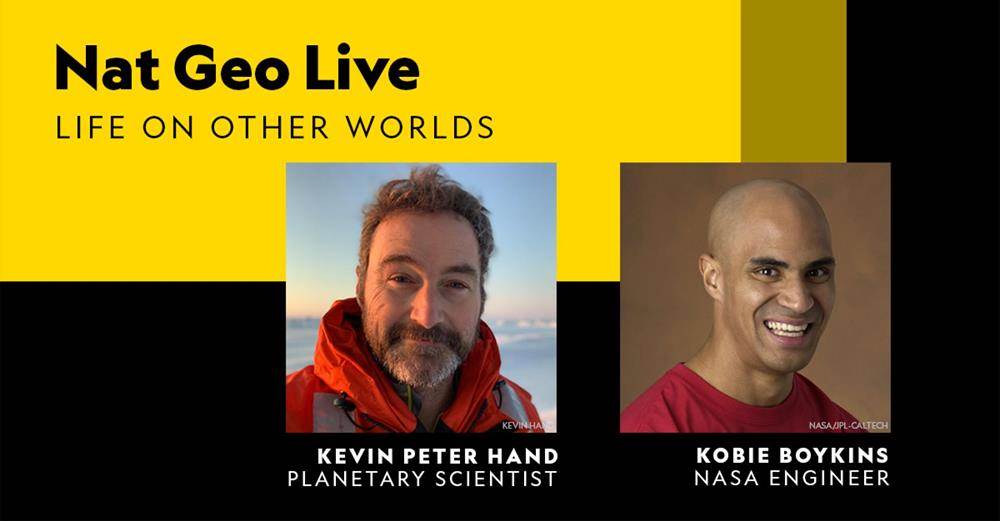National Geographic Live looked to the skies with a special event in partnership with venues across the country. Life on Other Worlds is a special 2-night event and fans who missed the January 19th presentation and Q&A can still get tickets to tonight’s (January 20th) second offering at 10 ET / 7 PT on the official website. Ticket sales go through venues that Nat Geo Live events are typically held in across the country. What follows is a recap of the January 19th event.
As the title suggests, Life on Other Worlds was about what kinds of life we expect to find within our own solar system and how we can find it. Moderator Andrew Pudvah hosted this event with guests Kobie Boykins and Kevin Peter Hand, both from NASA and specialized in different disciplines. Hand is a planetary scientist and astrobiologist and the author of Alien Oceans: The Search for Life in the Depths of Space. Boykins is an engineer who’s worked on several Mars rovers. To put it simply, scientists like Kevin Peter Hand tell engineers like Kobie Boykins where to look for life so they can solve the problem of how we get there to find it.
One of the really cool graphics displayed by Kobie Boykins showed a map of all the off-world missions that have been led by scientists around the world and where those research missions went. It made it clear that for all the times mankind has sent people and robots into space, we have only begun to explore the deepest parts of our own galaxy. During the Q&A portions, it was also clear that a lot of kids were tuned in and the two guests inspired them by saying their generation of explorers may be the ones to get there.
One of the biggest questions answered during the event was what would be required in order for life to exist on other planets (or moons, as the case ends up being). Kevin Peter Hand said that scientists used to think life on a planet was dependent on being the perfect distance from a parent star, but recent discoveries have proved otherwise. What really needs to be in place is having liquid water, roughly 54 elements from the period table and some form of energy that can create life.
You can get the science fiction version of life on other planets out of your head for now, Kevin shared that what we expect to find are single-celled organisms similar to how life began on Earth. While only a few spacecraft have gone beyond the asteroid belt, they have revealed evidence of oceans, particularly on the moons of Jupiter and Saturn. Outside of Earth, we know that Europa, Titan, Triton, Ganymede, Callisto and Enceladus all have oceans in our solar system. “Where you find liquid water, you almost always find life,” the scientist said. In addition, it is believed that Europa and Ganymede have the right amount of tidal tug and pull to produce an ocean with a very thin ice shelf.
Why would an ocean with an ice shelf be sustainable for life? As a planetary scientist, Kevin Peter Hand talked about the hydrothermal vents in Earth’s oceans that give rise to ecosystems that don’t get energy from the sun. The “Lost City” is an example of a hydrothermal vent that gets its energy from a chemical reaction called chemosynthesis that feeds microbes. Others are warmed by the heat in earth’s rocky core. In short, you can have life without energy from the sun, which means that these moons with oceans father out in our solar system could have single-celled organisms living there.
Kobie Boykins’ portion of the presentation was mostly about what we’ve learned from sending rovers to Mars, what the next mission plans to do, and what future missions to the moons highlighted by Kevin Peter Hand could look like. He started by walking viewers through animation of what the Mars Rover’s journey was like, spending only a minute to get into orbit, but over seven-months to get to Mars. Once it arrived, it’s bumpy landing included a parachute to slow its descent, inflating a tetrahedron air bag for a 45-minute bounce until it settled upright, and then a day to charge its solar panels before it could get to work. So much math is involved just to get the rover there, but the goal is to arrive at Mars’ version of noon so the solar panels can get enough of a charge for a full work day shortly after.
The camera on a Mars Rover stands at 5’2” so that the imagery NASA gets back is from a human-eye view. Another rover is on its ways there right now, scheduled to land on February 18th, 2021, which features a new landing procedure with thrusters that give scientists more control over how and where it lands, eliminating the rolling airbag process. This new rover, named Perseverance, will also be collecting samples from Mars that will be sent back to Earth, cleaned on their return journey to avoid microbial contamination. These samples are different from previous scraping missions, which were more about detecting ice on Mars. Another new experiment Perseverance will perform is called MOXIE, which stands for Mars Oxidation Experiment and can create oxygen to demonstrate how astronauts could create breathable air on Mars for future human missions to the red planet.
The hour-long presentation ended with each guest showing off a show & tell item. I’ll keep those a secret for anyone who plans to attend tonight’s event. Life on Other Worlds was a really cool look at what we can expect to find from future space exploration with an engaging Q&A component that was perfect for all ages. Don’t miss your chance to attend the second presentation tonight. Click here for more details.

